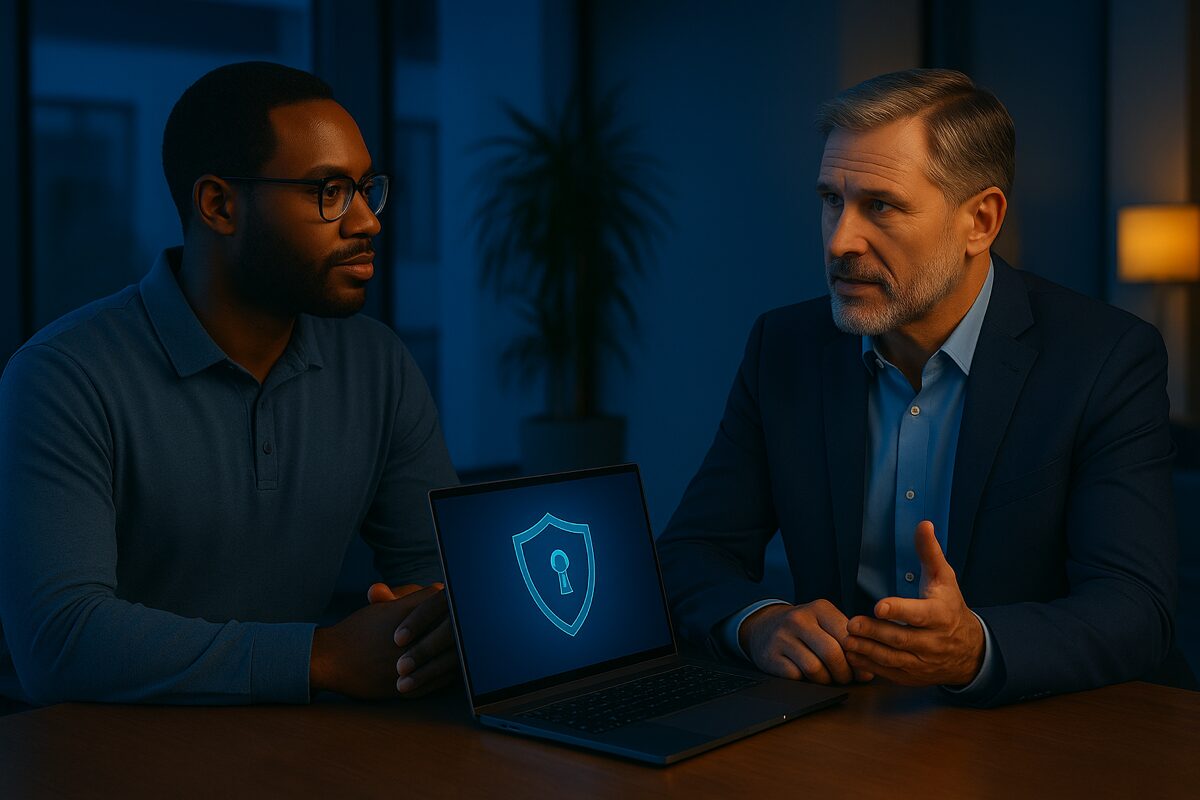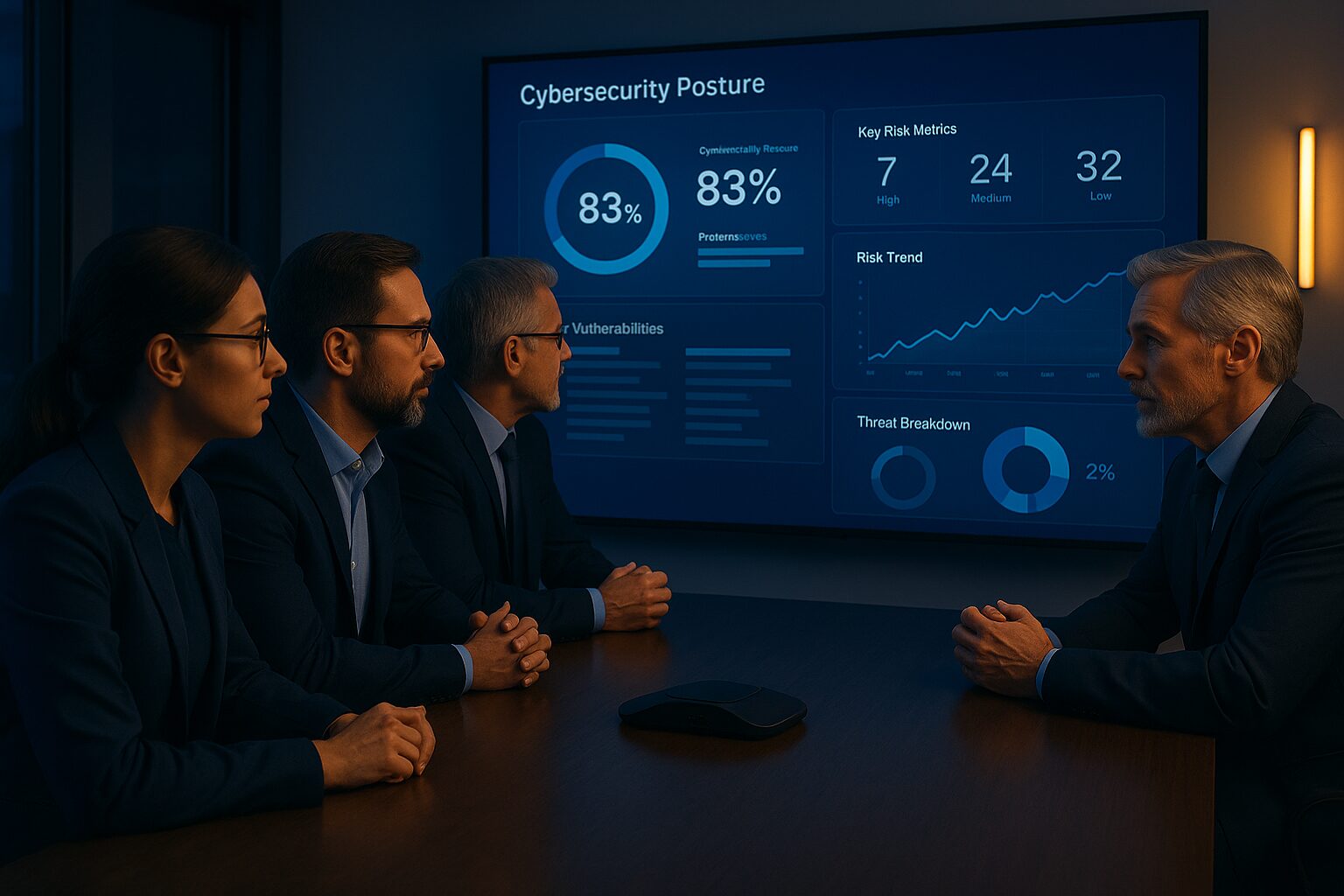Cybercrime is on the rise and if your employees don’t take security seriously, your company will be attacked at some point. This article will review how to protect against a cybersecurity data breach by strengthening your weakest link.
Summary
Cybersecurity is a critical concern for any organization, and it is crucial to recognize that employees are often the weakest link in a company’s information security. With the rise in cybercrime, it is no longer sufficient for organizations to rely solely on their IT departments to protect their assets. Instead, security is a shared responsibility between the company and its employees. While the organization is responsible for providing a secure environment and implementing robust security measures, employees must also play an active role in protecting the company’s assets from security incidents and data breaches. To achieve this, organizations must provide effective security awareness training for their employees and encourage them to follow through with their responsibilities.
The Company’s Responsibility
In today’s digital age, cybersecurity threats are becoming more sophisticated and frequent, and organizations need to be prepared to defend against them. One of the most effective ways to do this is by fostering a strong cybersecurity awareness culture within the organization. This means ensuring that all employees understand the importance of cybersecurity and are equipped with the knowledge and skills needed to identify and respond to potential threats.
Creating a potent cybersecurity awareness culture requires a comprehensive approach that includes a range of strategies and tactics, such as:
Designing a Cybersecurity Awareness Training Program
Responsible organizations take ownership of implementing a comprehensive cybersecurity training program because employees are often the weakest link in an organization’s cybersecurity defenses. A recent report detailed that nearly 90% of all data breaches are caused by human error.
By providing regular training and education on cyber threats, safe online behavior, and best practices for data protection, a company can help ensure that its employees are better equipped to identify and mitigate cyber risks. This can ultimately help to prevent data breaches, reduce the risk of financial losses, and safeguard the company’s reputation.
Here are some steps to help you create the perfect cybersecurity awareness training for your staff:
- Identify the training goals: Before starting the training program, you need to identify the specific goals and objectives you want to achieve. The goals may include reducing the risk of cyber attacks, identifying and reporting security incidents, and promoting a security-first culture among employees.
- Assess the training needs: Conduct a cybersecurity assessment to identify the areas where your employees need training. This may include identifying phishing emails, creating strong passwords, using secure networks, and handling sensitive data.
- Develop the training content: Based on the training goals and needs, develop the training content. This may include online modules, videos, quizzes, and interactive simulations.
- Make the training engaging: Cybersecurity awareness training can be tedious, so it’s essential to make it engaging and interactive. Use real-life examples, scenarios, and case studies to illustrate cybersecurity risks and best practices.
- Test and measure the training effectiveness: Once the training is developed, test it with a pilot group and measure its effectiveness. This will help you identify any gaps in the training and refine it further.
- Regularly update the training: Cybersecurity threats and best practices change constantly, so it’s essential to keep the training updated regularly. Review the training program at least once a year to ensure it is up-to-date and relevant.
- Promote a security-first culture: Lastly, it’s important to promote a security-first culture in your organization. Encourage employees to report security incidents, reward good cybersecurity practices, and prioritize cybersecurity at all levels of the organization.
By following these steps, you can build an effective cybersecurity awareness training program for your staff to help reduce the risk of cyber attacks and protect your organization’s sensitive data.
Security Awareness Training: What To Cover
It’s impossible to cover every cybersecurity topic in a few sittings, so it is important to hand-pick the most critical pieces to review and think through the cadence and delivery of your cybersecurity awareness training program for your staff. Here are a few quick recommendations:
Instill the Importance of Cybersecurity With Your Workforce
The importance of all employees playing their part in bettering the company’s cybersecurity culture cannot be overstated. Cybercriminals are becoming increasingly sophisticated as technology evolves, and their attacks are more targeted and damaging. Therefore, it is essential for employees to be aware of potential IT security risks and to understand how their actions can impact the organization’s security posture. For example, a single click on a phishing email or a weak password can be all it takes for cybercriminals to gain access to the organization’s network and steal sensitive data. By playing their part in bettering the company’s cybersecurity posture, employees can help reduce the risk of cyber attacks and safeguard the organization’s reputation and financial stability.
Review Company Security Policies
It is important to review company cybersecurity protocols during cybersecurity awareness training for employees. This ensures that all employees are aware of the policies and understand their role in maintaining the company’s cybersecurity defenses. It also provides an opportunity to reinforce key principles and procedures, answer questions and concerns, and identify areas where additional training or resources may be needed. Furthermore, reviewing cybersecurity policies during training helps to promote a culture of compliance and accountability, emphasizing the importance of adhering to policies and following best practices to protect the company’s information assets.
Detail the Most Common Cyber Threats
Including the most common cyber threats in cybersecurity awareness training for employees is important because it helps them understand the types of attacks that they may encounter in their daily work. By recognizing these threats, employees are better equipped to identify and respond to potential security incidents, minimizing the risk of a successful cyber attack.
Here is a list of common cybersecurity threats:
- Phishing attacks: These attacks attempt to trick users into revealing sensitive information, such as passwords or credit card details, by posing as a legitimate entity, such as a bank or a company.
- Malware: This is a type of software that is designed to damage or disable computer systems, steal information, or gain unauthorized access to networks. Malware can be introduced to systems through various means, including email attachments, downloads, removable media, and infected websites.
- Ransomware attacks: This is a type of malware that encrypts a victim’s files, making them inaccessible, and demands a ransom payment in exchange for the decryption key.
- Social engineering attacks: These attacks attempt to manipulate people into divulging confidential information or performing actions that could harm the organization.
- Password attacks: These attacks attempt to steal passwords or crack weak passwords through brute force methods.
- Insider threats: These threats can come from employees or other insiders who have access to sensitive information and may intentionally or unintentionally cause harm to the organization.
Cybersecurity Tips For Your Employees
To help protect sensitive data and operating systems at work, employees need to be aware of cybersecurity best practices. Below are some quick key tips that can help reduce the risk of cyber attacks and data breaches.
Use Strong Passwords: Employees should use strong passwords to safeguard their personal and professional information from unauthorized access. A strong password is one that is difficult to guess or hack, which helps keep sensitive data secure. Weak passwords can make it easier for hackers to access accounts, steal valuable information, and launch attacks on company networks and systems, leading to financial losses, reputational damage, and legal liability. Staff should use a combination of uppercase and lowercase letters, numbers, and special characters, avoid commonly used words or phrases, and regularly update passwords.
Don’t Reuse Passwords: Reusing passwords increases the risk of a cyber attack or data breach. If a password is reused across multiple accounts and one of those accounts is compromised, all other accounts with the same password become vulnerable. This practice can give cybercriminals easy access to personal and sensitive information, putting individuals and businesses at risk of identity theft, financial fraud, and other cybersecurity threats. By using unique passwords for each account, the risk of a breach is minimized, and the impact of a breach can be contained.
Use A Password Manager (Vault): Using a password manager (vault) can help protect against data breaches by providing a secure and convenient way to manage multiple passwords for different online accounts. Password managers allow users to generate and store strong, unique passwords for each account, reducing the risk of password reuse and making it harder for cybercriminals to guess or crack passwords. In addition, password managers often come with additional security features such as two-factor authentication, encryption, and secure password sharing, further enhancing the overall security of the password management process. Password managers also simplify the process of regularly changing passwords, which is recommended as a best practice for preventing data breaches.
Implement Authentication: Employees should use 2FA or MFA (multi-factor authentication) to add an additional layer of security to their accounts, as it requires a second form of identity verification beyond just a password, making it more difficult for attackers to gain unauthorized access to their accounts and sensitive information.
Keep A Clean Desk: A clean desk protects against cyber attacks because physical documents, passwords, or sensitive information left out in the open can be photographed, copied, or stolen, providing attackers with access to important information they can use to gain unauthorized access to company systems or networks.
Lock Devices: Locking devices is important in protecting against data breaches because it helps prevent unauthorized access to sensitive information or theft. When a device is locked, it requires a password, PIN, biometric verification, or other authentication method to access the data stored on the device.
Physical Security is Still Important: Physical security is important when protecting against data breaches because it helps prevent unauthorized access to physical devices or facilities where sensitive data is stored or processed. Even with advanced cybersecurity measures in place, physical access to devices or facilities can allow attackers to steal or tamper with data, install malware, or compromise systems. Physical security measures, such as access controls, surveillance, and environmental controls, help reduce the risk of unauthorized physical access and complement cybersecurity measures to provide a more robust defense against data breaches.
Don’t Become a Victim of Social Engineering: Social engineering attacks typically use psychological manipulation or deception to trick individuals into divulging confidential information, such as passwords or account details, or performing actions that could compromise security. Employees should be aware of the common tactics used by cybercriminals, such as phishing, pretexting, or baiting, and be cautious of unsolicited emails or phone calls requesting sensitive information. They should verify the identity of any individual requesting access to sensitive information or systems, use strong passwords, and follow established verification protocols. Additionally, they should be vigilant of warning signs and report any suspicious activity immediately to the appropriate personnel.
Understand Mobile Device Security: Mobile device security is crucial for employees to protect against data breaches because these endpoints are highly vulnerable to cyber attacks. With the increasing use of mobile devices in the workplace, employees often access sensitive corporate data and confidential information on the go. If these devices are not secured properly, they can become an easy target for cybercriminals who can steal data, install malware, and compromise the entire network. By implementing strong mobile device security measures, such as password protection, data encryption, and regular software updates, employees can safeguard their devices and reduce the risk of a data breach, thereby protecting their company’s reputation, finances, and customer trust.
Observe Remote Working Protocols: Working remotely has its advantages, but it can also increase the risk of a data breach, so employees need to take proactive steps to protect themselves and their organization. Remote workers should use a secure and encrypted network connection, use strong and unique passwords with multi-factor authentication, keep their devices and software up-to-date, use a virtual private network (VPN), be cautious of social engineering attacks, avoid public Wi-Fi, store data in secure and encrypted locations, and use endpoint security solutions such as antivirus and anti-malware software.
Never Use Public Wi-Fi: Employees should avoid using public Wi-Fi because these networks are often unsecured, meaning that the data transmitted over them can be easily intercepted and compromised by hackers. Public Wi-Fi networks are also more susceptible to man-in-the-middle attacks, where a hacker intercepts the communication between the user and the network and steals sensitive information such as passwords, credit card details, or other confidential data. Additionally, cybercriminals often set up fake Wi-Fi hotspots that mimic legitimate ones, tricking users into connecting to them and giving away their data. To prevent these types of attacks, employees should use a secure, encrypted connection, such as a Virtual Private Network (VPN), to protect their data and ensure their privacy when working remotely.
Be Smart About Social Media: Social media use can lead to a cyber attack in several ways. Cybercriminals can use social engineering tactics, such as phishing scams, to trick users into revealing their login credentials, personal information, or financial details. In addition, malicious actors can create fake social media profiles to spread malware or engage in fraudulent activities, such as spamming or phishing. Furthermore, social media platforms themselves can be vulnerable to data breaches, where hackers gain unauthorized access to sensitive user data, such as email addresses, passwords, or credit card details. Once cybercriminals have obtained this information, they can use it to launch targeted attacks, such as identity theft, financial fraud, or ransomware.
Explore the Internet Safely: Employees need to know that Internet usage can lead to a data breach if they are not careful about the websites they visit, the files they download, and the links they click on. Malicious websites or pop-ups can infect a user’s device with malware, which can steal sensitive data, log keystrokes, or spy on online activities.
Use Current Browser Security: Browser security helps avoid data breaches by protecting users from various types of cyber threats, including phishing, malware, and other malicious attacks that can compromise their sensitive information. Some common browser security features include pop-up blockers, anti-phishing and anti-malware filters, privacy settings, and secure connections using HTTPS. These features help users identify and avoid malicious websites and downloads, prevent unauthorized access to their data, and ensure the confidentiality and integrity of their online activities. Additionally, regular updates to the browser software can patch vulnerabilities and enhance the overall security of the browsing experience.
Report Incidents: Incident reporting by employees is critical in avoiding data breaches because it helps security teams identify and mitigate the vulnerability or threat, contain the breach, and prevent further unauthorized access or damage. It can also facilitate a culture of cybersecurity awareness and vigilance within the organization, which can encourage other employees to report security incidents as well. Additionally, incident reporting enables organizations to comply with legal and regulatory requirements related to data breaches, which can help avoid legal penalties and reputational damage.
Keep Educating Yourself: Ongoing cybersecurity awareness training can help employees protect against a data breach in several ways. Firstly, it can provide them with up-to-date knowledge of the latest cybersecurity threats and best practices for preventing and responding to data breaches. This can include education on how to identify and avoid phishing scams, how to use secure passwords and multi-factor authentication, and how to keep software and systems updated and patched. Security awareness training can also provide employees with opportunities to practice their skills in simulated scenarios and exercises, which can help them better understand how to respond to a data breach in a real-world situation. Finally, ongoing security learning can promote a culture of security within the organization, helping employees understand the importance of data security and their role in protecting sensitive information.
Meriplex Can Strengthen Your Cybersecurity
While some companies may have the resources and expertise to design and implement a robust cybersecurity awareness culture in-house, others may prefer to work with a managed security provider like Meriplex. Managed security services providers can provide a range of services, including employee training, risk assessments, network security, and incident response planning, to help organizations strengthen their cybersecurity posture. If you are interested in learning more about what Meriplex can do for your organizational security posture, please contact us today!



